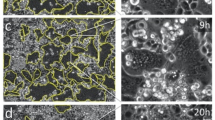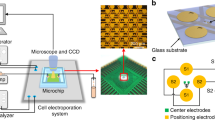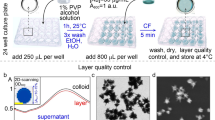Abstract
Complete fusion of two selected cells allows for the creation of novel hybrid cells with inherited genetic properties from both original cells. Alternatively, via fusion of a selected cell with a selected vesicle, chemicals or genes can be directly delivered into the cell of interest, to control cellular reactions or gene expression. Here, we demonstrate how to perform an optically controlled fusion of two selected cells or of one cell and one vesicle. Fusion is mediated by laser irradiating plasmonic gold nanoparticles optically trapped between two cells (or a vesicle and a cell) of interest. This hot-particle-mediated fusion causes total mixing of the two cytoplasms and the two cell membranes resulting in formation of a new hybrid cell with an intact cell membrane and enzymatic activity following fusion. Similarly, fusion between a vesicle and a cell results in delivery of the vesicle cargo to the cytoplasm, and after fusion, the cell shows signs of viability. The method is an implementation of targeted drug delivery at the single-cell level and has a great potential for cellular control and design.

Similar content being viewed by others
References
Martens, S.; McMahon, H. T. Mechanisms of membrane fusion: Disparate players and common principles. Nat. Rev. Mol. Cell Biol. 2008, 9, 543–556.
Chen, Y. A.; Scheller, R. H. SNARE-mediated membrane fusion. Nat. Rev. Mol. Cell Biol. 2001, 2, 98–106.
Pérez-Vargas, J.; Krey, T.; Valansi, C.; Avinoam, O.; Haouz, A.; Jamin, M.; Raveh-Barak, H.; Podbilewicz, B.; Rey, F. A. Structural basis of eukaryotic cell-cell fusion. Cell 2014, 157, 407–419.
Brouwer, I.; Giniatullina, A.; Laurens, N.; van Weering, J. R. T.; Bald, D.; Wuite, G. J. L.; Groffen, A. J. Direct quantitative detection of Doc2b-induced hemifusion in optically trapped membranes. Nat. Commun. 2015, 6, 8387.
Weber, T.; Zemelman, B. V.; McNew, J. A.; Westermann, B.; Gmachl, M.; Parlati, F.; Söllner, T. H.; Rothman, J. E. SNAREpins: Minimal machinery for membrane fusion. Cell 1998, 92, 759–772.
Floyd, D. L.; Ragains, J. R.; Skehel, J. J.; Harrison, S. C.; van Oijen, A. M. Single-particle kinetics of influenza virus membrane fusion. Proc. Natl. Acad. Sci. USA 2008, 105, 15382–15387.
Estes, D. J.; Lopez, S. R.; Fuller, A. O.; Mayer, M. Triggering and visualizing the aggregation and fusion of lipid membranes in microfluidic chambers. Biophys. J. 2006, 91, 233–243.
Longo, M. L.; Waring, A. J.; Hammer, D. A. Interaction of the influenza hemagglutinin fusion peptide with lipid bilayers: Area expansion and permeation. Biophys. J. 1997, 73, 1430–1439.
Chakraborty, H.; Mondal, S.; Sarkar, M. Membrane fusion: A new function of non steroidal anti-inflammatory drugs. Biophys. Chem. 2008, 137, 28–34.
Ohki, S. Effects of divalent cations, temperature, osmotic pressure gradient, and vesicle curvature on phosphatidylserine vesicle fusion. J. Membr. Biol. 1984, 77, 265–275.
Wilschut, J.; Duezguenes, N.; Papahadjopoulos, D. Calcium/ magnesium specificity in membrane fusion: Kinetics of aggregation and fusion of phosphatidylserine vesicles and the role of bilayer curvature. Biochemistry 1981, 20, 3126–3133.
van Lengerich, B.; Rawle, R. J.; Bendix, P. M.; Boxer, S. G. Individual vesicle fusion events mediated by lipid-anchored DNA. Biophys. J. 2013, 105, 409–419.
Rawle, R. J.; van Lengerich, B.; Chung, M.; Bendix, P. M.; Boxer, S. G. Vesicle fusion observed by content transfer across a tethered lipid bilayer. Biophys. J. 2011, 101, L37–L39.
Haluska, C. K.; Riske, K. A.; Marchi-Artzner, V.; Lehn, J. M.; Lipowsky, R.; Dimova, R. Time scales of membrane fusion revealed by direct imaging of vesicle fusion with high temporal resolution. Proc. Natl. Acad. Sci. USA 2006, 103, 15841–15846.
Saito, A. C.; Ogura, T.; Fujiwara, K.; Murata, S.; Nomura, S.-I. M. Introducing micrometer-sized artificial objects into live cells: A method for cell–giant unilamellar vesicle electrofusion. PLoS One 2014, 9, e106853.
Robinson, T.; Verboket, P. E.; Eyer, K.; Dittrich, P. S. Controllable electrofusion of lipid vesicles: Initiation and analysis of reactions within biomimetic containers. Lab Chip 2014, 14, 2852–2859.
Yeheskely-Hayon, D.; Minai, L.; Golan, L.; Dann, E. J.; Yelin, D. Optically induced cell fusion using bispecific nanoparticles. Small 2013, 9, 3771–3777.
Rørvig-Lund, A.; Bahadori, A.; Semsey, S.; Bendix, P. M.; Oddershede, L. B. Vesicle fusion triggered by optically heated gold nanoparticles. Nano Lett. 2015, 15, 4183–4188.
Bendix, P. M.; Jauffred, L.; Norregaard, K.; Oddershede, L. B. Optical trapping of nanoparticles and quantum dots. IEEE J. Sel. Top. Quant. 2014, 20, 4800112.
Richardson, A. C.; Reihani, N.; Oddershede, L. B. Combing confocal microscopy with precise force-scope optical tweezers. In Proceedings of SPIE 6326, Optical Trapping and Optical Micromanipulation III, San Diego, California, USA, 2006.
Reihani, S. N. S.; Mir, S. A.; Richardson, A. C.; Oddershede, L. B. Significant improvement of optical traps by tuning standard water immersion objectives. J. Opt. 2011, 13, 105301.
Hansen, P. M.; Bhatia, V. K.; Harrit, N.; Oddershede, L. Expanding the optical trapping range of gold nanoparticles. Nano Lett. 2005, 5, 1937–1942.
Bendix, P. M.; Reihani, S. N. S.; Oddershede, L. B. Direct measurements of heating by electromagnetically trapped gold nanoparticles on supported lipid bilayers. ACS Nano 2010, 4, 2256–2262.
Kyrsting, A.; Bendix, P. M.; Stamou, D. G.; Oddershede, L. B. Heat profiling of three-dimensionally optically trapped gold nanoparticles using vesicle cargo release. Nano Lett. 2011, 11, 888–892.
Kaneshiro, E. S.; Wyder, M. A.; Wu, Y.-P.; Cushion, M. T. Reliability of calcein acetoxy methyl ester and ethidium homodimer or propidium iodide for viability assessment of microbes. J. Microbiol. Meth. 1993, 17, 1–16.
Gatti, R.; Belletti, S.; Orlandini, G.; Bussolati, O.; Dall'Asta, V.; Gazzola, G. C. Comparison of annexin V and calcein- AM as early vital markers of apoptosis in adherent cells by confocal laser microscopy. J. Histochem. Cytochem. 1998, 46, 895–900.
Stockert, J. C.; Blázquez-Castro, A.; Cañete, M.; Horobin, R. W.; Villanueva, Á. MTT assay for cell viability: Intracellular localization of the formazan product is in lipid droplets. Acta Histochem. 2012, 114, 785–796.
Liu, Y.; Peterson, D. A.; Kimura, H.; Schubert, D. Mechanism of cellular 3-(4,5-dimethylthiazol-2-yl)-2,5-diphenyltetrazolium bromide (MTT) reduction. J. Neurochem. 1997, 69, 581–593.
Ogle, B. M.; Cascalho, M.; Platt, J. L. Biological implications of cell fusion. Nat. Rev. Mol. Cell Biol. 2005, 6, 567–575.
Gong, J. L.; Nikrui, N.; Chen, D. S.; Koido, S.; Wu, Z. K.; Tanaka, Y.; Cannistra, S.; Avigan, D.; Kufe, D. Fusions of human ovarian carcinoma cells with autologous or allogeneic dendritic cells induce antitumor immunity. J. Immunol. 2000, 165, 1705–1711.
Giordano-Santini, R.; Linton, C.; Hilliard, M. A. Cell-cell fusion in the nervous system: Alternative mechanisms of development, injury, and repair. Semin. Cell Dev. Biol., in press, DOI: 10.1016/j.semcdb.2016.06.019.
Vassilopoulos, G.; Wang, P. R.; Russell, D. W. Transplanted bone marrow regenerates liver by cell fusion. Nature 2003, 422, 901–904.
Jang, H. S.; Hong, Y. J.; Choi, H. W.; Song, H.; Byun, S. J.; Uhm, S. J.; Seo, H. G.; Do, J. T. Changes in parthenogenetic imprinting patterns during reprogramming by cell fusion. PLoS One 2016, 11, e0156491.
Bendix, P. M.; Oddershede, L. B. Expanding the optical trapping range of lipid vesicles to the nanoscale. Nano Lett. 2011, 11, 5431–5437.
Oyama, K.; Arai, T.; Isaka, A.; Sekiguchi, T.; Itoh, H.; Seto, Y.; Miyazaki, M.; Itabashi, T.; Ohki, T.; Suzuki, M. et al. Directional bleb formation in spherical cells under temperature gradient. Biophys. J. 2015, 109, 355–364.
Biondi, O.; Motta, S.; Mosesso, P. Low molecular weight polyethylene glycol induces chromosome aberrations in Chinese hamster cells cultured in vitro. Mutagenesis 2002, 17, 261–264.
Baffou, G.; Berto, P.; Bermúdez Ureña, E.; Quidant, R.; Monneret, S.; Polleux, J.; Rigneault, H. Photoinduced heating of nanoparticle arrays. ACS Nano 2013, 7, 6478–6488.
Pott, T.; Bouvrais, H.; Méléard, P. Giant unilamellar vesicle formation under physiologically relevant conditions. Chem. Phys. Lipids 2008, 154, 115–119.
Estes, D. J.; Mayer, M. Giant liposomes in physiological buffer using electroformation in a flow chamber. Biochim. Biophys. Acta 2005, 1712, 152–160.
Montes, L. R.; Alonso, A.; Goñi, F. M.; Bagatolli, L. A. Giant unilamellar vesicles electroformed from native membranes and organic lipid mixtures under physiological conditions. Biophys. J. 2007, 93, 3548–3554.
Weinberger, A.; Tsai, F.-C.; Koenderink, G. H.; Schmidt, T. F.; Itri, R.; Meier, W.; Schmatko, T.; Schröder, A.; Marques, C. Gel-assisted formation of giant unilamellar vesicles. Biophys. J. 2013, 105, 154–164.
Luby-Phelps, K. Cytoarchitecture and physical properties of cytoplasm: Volume, viscosity, diffusion, intracellular surface area. Int. Rev. Cytol. 2000, 192, 189–221.
Fujiwara, T.; Ritchie, K.; Murakoshi, H.; Jacobson, K.; Kusumi, A. Phospholipids undergo hop diffusion in compartmentalized cell membrane. J. Cell Biol. 2002, 157, 1071–1082.
Andersen, T.; Kyrsting, A.; Bendix, P. M. Local and transient permeation events are associated with local melting of giant liposomes. Soft Matter 2014, 10, 4268–4274.
Li, M.; Lohmuller, T.; Feldmann, J. Optical injection of gold nanoparticles into living cells. Nano Lett. 2015, 15, 770–775.
McDougall, C.; Stevenson, D. J.; Brown, C. T. A.; Gunn-Moore, F.; Dholakia, K. Targeted optical injection of gold nanoparticles into single mammalian cells. J. Biophotonics 2009, 2, 736–743.
Andersen, T.; Bahadori, A.; Ott, D.; Kyrsting, A.; Reihani, S. N.; Bendix, P. M. Nanoscale phase behavior on flat and curved membranes. Nanotechnology 2014, 25, 505101.
Pan, J. J.; Heberle, F. A.; Tristram-Nagle, S.; Szymanski, M.; Koepfinger, M.; Katsaras, J.; Kučerka, N. Molecular structures of fluid phase phosphatidylglycerol bilayers as determined by small angle neutron and X-ray scattering. Biochim. Biophys. Acta 2012, 1818, 2135–2148.
Acknowledgements
The authors acknowledge financial support from the Lundbeck Foundation, the Villum Kann Rasmussen Foundation (No. VKR022593), the Danish Council for Independent Research DFF–4181-00196, from the Danish National Research Foundation (No. DNRF116) and from the Novo Nordisk Foundation (No. NNF14OC0011361).
Author information
Authors and Affiliations
Corresponding authors
Electronic supplementary material
Rights and permissions
About this article
Cite this article
Bahadori, A., Oddershede, L.B. & Bendix, P.M. Hot-nanoparticle-mediated fusion of selected cells. Nano Res. 10, 2034–2045 (2017). https://doi.org/10.1007/s12274-016-1392-3
Received:
Revised:
Accepted:
Published:
Issue Date:
DOI: https://doi.org/10.1007/s12274-016-1392-3




